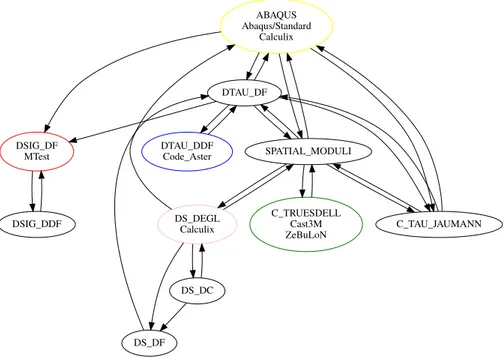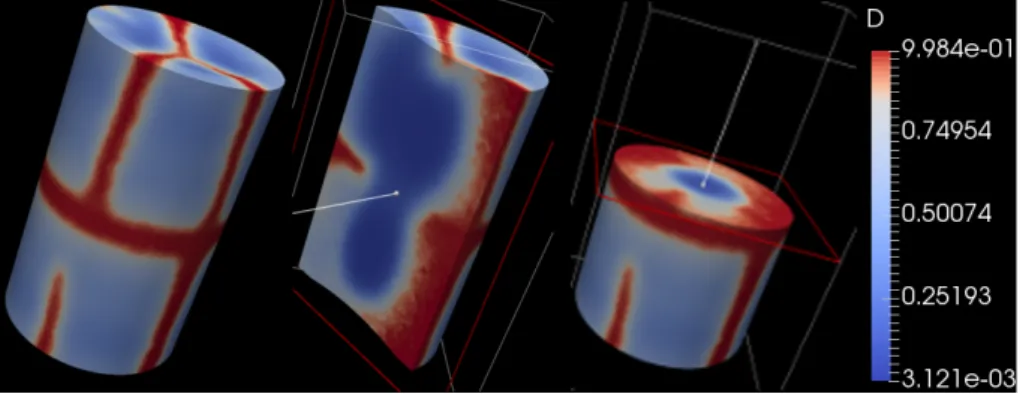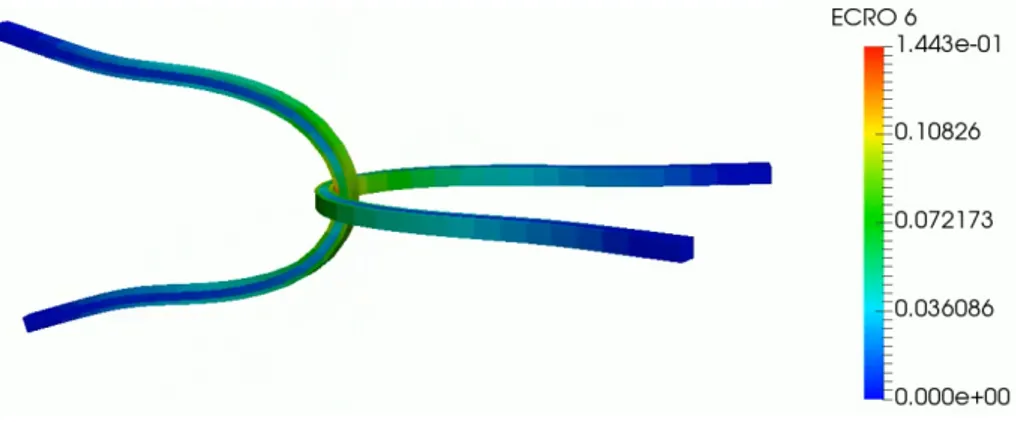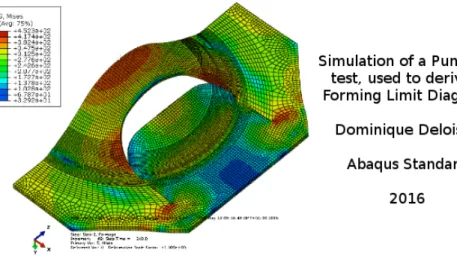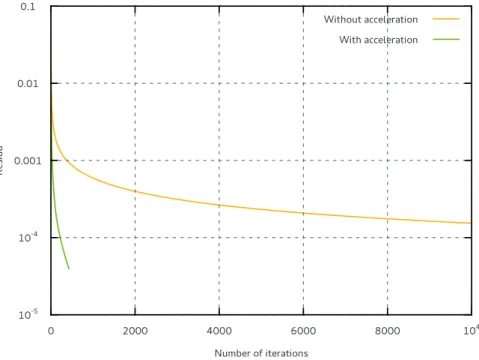HAL Id: hal-01922019
https://hal.archives-ouvertes.fr/hal-01922019
Submitted on 14 Nov 2018
HAL is a multi-disciplinary open access
archive for the deposit and dissemination of sci-entific research documents, whether they are pub-lished or not. The documents may come from teaching and research institutions in France or abroad, or from public or private research centers.
L’archive ouverte pluridisciplinaire HAL, est destinée au dépôt et à la diffusion de documents scientifiques de niveau recherche, publiés ou non, émanant des établissements d’enseignement et de recherche français ou étrangers, des laboratoires publics ou privés.
New functionalities of the 3.0 version of TFEL, MFront
and MTest
Thomas Helfer, Olivier Fandeur, David Haboussa, Dominique Deloison,
Olivier Jamond, Rémi Munier, Lucie Berthon, Etienne Castelier, Isabelle
Ramière
To cite this version:
Thomas Helfer, Olivier Fandeur, David Haboussa, Dominique Deloison, Olivier Jamond, et al.. New functionalities of the 3.0 version of TFEL, MFront and MTest. 13e colloque national en calcul des structures, Université Paris-Saclay, May 2017, Giens, Var, France. �hal-01922019�
CSMA 2017
13ème Colloque National en Calcul des Structures 15-19 Mai 2017, Presqu’île de Giens (Var)
New functionalities of the 3.0 version of TFEL, MFront and
MTest
Thomas Helfer1, Olivier Fandeur2,3, David Haboussa4, Dominique Deloison5, Olivier
Jamond6, Rémi Munier7, Lucie Berthon8, Étienne Castelier9, Isabelle Ramière10
1 CEA, DEN/DEC/SESC, Département d’Études des Combustibles, thomas.helfer@cea.fr
2 CEA, DEN/DM2S/SEMT, Département de Modélisation des Systèmes et des Structures, olivier.fandeur@cea.fr 3 IMSIA, UMR 8193, CNRS-EDF-CEA-ENSTA
4 EDF R&D, Département Analyses Mécaniques et Acoustique, david.haboussa@edf.fr 5 Airbus Group Innovations, Structure Design & Analyses, dominique.deloison@airbus.com
6 CEA, DEN/DM2S/SEMT, Département de Modélisation des Systèmes et des Structures, olivier.jamond@cea.fr 7 EDF R&D, Département Matériaux et Mécanique des Composants, remi.munier@edf.fr
8 EDF R&D, Département SImulation NEutronique, Technologies de l’Information et Calcul Scientifique, lucie.berthon@edf.fr 9 CEA, DEN/DEC/SESC, Département d’Études des Combustibles, etienne.castelier@cea.fr
10 CEA, DEN/DEC/SESC, Département d’Études des Combustibles, isabelle.ramiere@cea.fr
Abstract — MFront is a tool which allows easy implementation of abritrary complex
mechan-ical behaviours in an efficient way. Those implementations are portable between various finite element solvers and solvers based on FFT. MFront is part of the open-source TFEL project which also provide an useful point-wise solver called MTest.
The purpose of this paper is to present the 3.0 version of TFEL, MFront and MTest.
1 Overview of TFEL, MFront and MTest
The TFEL project is an open-source collaborative development of the French Alternative Energies and Atomic Energy Commission (CEA) and Électricité de France (EDF) in the framework of the PLEIADES plateform (see (1)). TFEL provides mathematical libraries which are the basis of the MFront code generator and the MTest solver (see (2, 3)).
MFront translates a set of closely related domain specific languages into plain C++ on top of the TFEL library. Those languages are meant to be easy to use and learn by researchers and engineers and cover three kinds of material knowledge:
• Material properties (for instance Young modulus, thermal conductivity, etc.) • Mechanical behaviours.
• Simple point-wise models, such as material swelling used in fuel performance codes. Authors of MFront paid particular attention to the robustness, reliability and numerical efficiency of the generated code, in particular for mechanical behaviours: various benchmarks show that MFront implementations are competitive with native implementations available in the Cast3M (4), Code_Aster (5), Europlexus (6), Abaqus/Standard , Abaqus/Explicit (7, 8) and Cyrano3 (9) solvers.
Portability is also a very important issue: a behaviour written in MFront shall be usable in a solvers for which an interface exists. For example, for finite strain analysis, each solver has chosen a specific definition of the consistent tangent operator. MFront will convert the operator provided by the user, who is free to choose the most convenient operator to ease the implementation effort, into the one expected by the solver. The conversion paths currently available are depicted on Figure 1.
DSIG_DF MTest
DSIG_DDF C_TRUESDELLCast3M ZeBuLoN SPATIAL_MODULI DTAU_DDF Code_Aster DTAU_DF ABAQUS Abaqus/Standard Calculix C_TAU_JAUMANN DS_DEGL Calculix DS_DF DS_DC
Figure 1: “Relation between tangent operators”
MTest is a tool created to perform unit-testings on the mechanical behaviours generated by MFront.
1.1 How to get TFEL and MFront
TFEL is distributed with the Code_Aster finite element solver (see (5)), the Salome-Meca plate-form (see also (5)) and the Material Ageing Plateplate-form (MAP), which is available for all members of the Material Ageing Institute (MAI) (see (10, 11)).
Sources of TFEL can be downloaded from its website (see (12)). Binaries for the Windows operating system which are built upon versions of the Cast3M finite element solver are also available.
2 Highlights
From a user point of view, TFEL 3.0 brings many game-changing features which are described hereafter:
• New mechanical behaviour interfaces to several finite element solvers (Europlexus, Abaqus/Standard, Abaqus/Explicit, CalculiX)
• The support of behaviours bricks, described below.
• The ability to simulate pipes using a rigourous finite strain framework in MTest
• The introduction of various accelerations algorithms used for solving the mechanical equi-librium when the consistent tangent operator is not available (see (13)).
• The development of a stable API (application programming interface) in C++ and python which allow building external tools upon MFront and MTest. This point is illustrated by the development by EDF MMC in the Material Ageing Plateform of a new identification tool which is particularly interesting.
Many improvements for mechanical behaviours have also been made, which won’t be detailed in this paper:
Figure 2: Phase field modelling of the nuclear fuel pellet fragmentation during the reactor start-up (see (15) for details)
• Definition and automatic computation of elastic material properties from external MFront files.
• Support for the automatic computation of the thermal expansion and swelling in the mechanical behaviour.
• Better support for orthotropic behaviours with the notion of orthotropic convention which affects various keywords (@ComputeStiffnessTensor, @ComputeThermalExpansion, @Swelling, @AxialGrowth, @HillTensor etc..).
• An initial support of non local mechanical behaviours. See for example Figure 2. • Time steps management from the mechanical behaviour.
• Consistent tangent operator support in the Cast3M interface.
• Easier computations of isotropic functions of symmetric tensors and their derivatives. • New material properties interfaces for various programming languages (fortran03, java,
GNU/Octave).
2.1 New interfaces
2.1.1 Europlexus
Europlexus (EPX) is a simulation software dedicated to the analysis of fast transient phenomena involving structures and fluids in interaction. The program is co-owned by the French Alternative Energies and Atomic Energy Commission (CEA) and the Joint Research Centre of the European Commission (EC/JRC). Its development is carried out through a Consortium involving the co-owners and so-called major partners who are granted a complete access to the source code and development tools (see (6)).
The ability to call external libraries generated by MFront has been introduced in the current developpement version of EPX. When loading a MFront behaviour, Europlexus automatically retrieves various helpfull information about the mechanical behaviour:
• Number and name of material properties
• Number, names and type of internal state variables • Number and names of external variables
• Symmetry of the behaviour (isotropy, entropy) • etc…
This information allows to check that the material declaration is consistent and reduces the inputs provided by the user to the bare minimal. A similar technique is used in Code_Aster and MTest when calling MFront generated behaviours.
The following features are currently available: • Support for finite strain behaviours
• Support for isotropic and orthotropic behaviours
• Automatic generation of an input file example to help the user in assigning a MFront behaviour to a material.
2.1.1.2 Finite strain strategies
Small strain behaviours can be embedded through finite strain strategies: currently, MFront provides (see (16, 17)):
• the FiniteRotationSmallStrain strategy: based on the Green-Lagrange strain measure. • the MieheApelLambrechtLogarithmicStrain strategy based on the lagrangian Hencky
strain measure.
In both cases, the strain measure is computed before calling the behaviour and the stress tensor resulting from the behaviour integration is interpreted as the dual of this strain measure. This stress tensor is then converted into the Cauchy stress tensor for computing the nodal forces.
2.1.1.3 Performances
Figure 3: Impact of two bars Figure 3 shows a simple test simulating the impact of two bars.
Table 1: Example of comparison of the computation times for the test depicted on Figure 3 for various behaviours de-scribing istropic plasticity with linear isotropic hardening.
Behaviour Computational times
native 174s
MFront FiniteRotationSmallStrain 232s
MFront ImplicitSimoMieheElastoPlasticity 250s
MFront MieheApelLambrechtLogarithmicStrain 528s
This tests show that, for simple behaviours describing isotropic plasticty, MFront behaviours seems a bit less efficient than Fortran built-in implementations, as reported on Table 1. However, it shall be stated that the behaviours tested are not strictly equivalent (native behaviours are based on objective stress rates while MFront ones are hyperelastoplastic). MFront computational times can be improved by keeping some intermediate results for one step to the next to the expense of memory usage.
This interface is fully described here: http://tfel.sourceforge.net/epx.html 4
Acknowledgements This work was accomplished within the framework of the “dynamique rapide” project, financially supported by the CEA and EDF.
2.1.2 Abaqus/Standard, Abaqus/Explicit and CalculiX
The Abaqus Unified FEA product suite provides:
• an implicit finite element solver, called Abaqus/Standard, which can be extended using the umat subroutine.
• an explicit finite element solver, called Abaqus/Explicit, which can be extended using the vumat subroutine.
MFront provides an interface for these two solvers and strives to allow the user restart a compu-tation while switching from one solver to the other: a feature which is not easy to implement as these solvers use different conventions and, by default, different kinematics assumptions. The Abaqus/Standard interface can also be used to extend the CalculiX finite element solver (see (18)).
2.1.2.1 Calling MFront behaviours from Abaqus/Standard or Abaqus/Explicit
Calling a behaviour from Abaqus/Standard or Abaqus/Explicit is a two steps process:
• Compiling a MFront library before launching either Abaqus/Standard or Abaqus/Explicit. This allows the creation of a set of libraries that can be shared between co-workers (for example, by copying them in shared folders).
• Launching Abaqus/Standard or Abaqus/Explicit with a general purpose umat or vumat subroutine which handles the loading of the MFront library and the call of the appropriate behaviour. The material name as declared in the input file must contains the name of the library and the name of the behaviour and the modelling hypothesis.
2.1.2.2 Features supported
For every behaviour, example of input file are automatically generated.
The MFront interface for the Abaqus/Standard solver supports orthotropic and isotropic, small and finite strain behaviours. For isotropic behaviours written in the small strain framework, internal state variables are automatically and properly rotated in finite strain analyses.
Concerning Abaqus/Explicit, we support orthotropic and isotropic finite strain behaviours. In both cases, we offer three finite strain strategies to use small strain behaviours implementa-tions in finite strain:
• The Native one which uses Abaqus native strategy to handle behaviour written in rate-form.
• The FiniteRotationSmallStrain strategy (see (16)).
• The MieheApelLambrechtLogarithmicStrain strategy (see (17)).
2.1.2.3 Performances
In Abaqus/Standard, our tests show that the performances of MFront generated behaviours are on par with native behaviours (even slightly better in some cases): those results were quite surprising because we expected the manual handling of the external libraries at the Gauss point level to be a performance bottleneck.
Figure 4: Simulation of a Punching test
Table 2: Comparison of computational times for a simple isotropic plasticity behaviour with linear kinematic hardening applied to the punching test depicted on Figure 4.
Implementation Computational times
Native 638s
VUMAT (Fortran) 762s
MFront 788s
In Abaqus/Explicit, we found that our implementations are about 20 % slower than the na-tive ones on the simulation of the punching test depicted on Figure 4 for an isotropic plastic behaviour with linear isotropic hardening. However, our implementations are nearly equivalent to VUMAT implementations described in (19) (see Table 2). This difference can have several explanations:
• the VUMAT implementation is based on an update of the stresses whereas the MFront im-plementation keeps the elastic strain as an internal state variable.
• the VUMAT implementation is compiled using the INTEL compiler and the MFront imple-mentation is compiled with gcc.
2.1.2.4 Additional documentations
A dedicated page has been created describing the current features of these interfaces, the poten-tial pitfalls, and the choices that were made to support some behaviours, for example orthotropic finite strain behaviours: http://tfel.sourceforge.net/abaqus.html
A specific talk of the Second MFront User Day has been dedicated to those interfaces (see (8)).
2.2 Behaviour bricks
Behaviour bricks allow the use of predefined parts of a behaviour. For example, the StandardElasticity brick handles:
• The computation of the stress according to the Hooke law, taking into account the evolution of the elastic material properties if necessary.
• The computation of an elastic prediction of the stresses, taking into account the modelling hypothesis.
• The computation of the tangent operator.
• The computation of a minimal prediction operator. • The computation of the stored and dissipated energy.
• The additional equations associated with the plane stress and generalised plane stresss modelling hypotheses support.
This brick works with isotropic of orthotropic small-strain behaviours implemented using the Implicit domain specific language.
The use of bricks leads to much smaller, more robust and more portable implementations of mechanical behaviours. The user can focus on the specific parts of the behaviour. Listing 2.2 shows how a implicit implementation with analytical jacobian of the Norton behaviours can now be written in about 25 lines of codes (without the blank and comment lines).
1 @DSL Implicit;
2 @Behaviour ImplicitNorton; 3 @ModellingHypotheses {".+"}; 4 @Brick StandardElasticity;
5 @Epsilon 1.e-16; 6 7 @ElasticMaterialProperties {150e9,0.3}; 8 9 @StateVariable strain p; 10 p.setGlossaryName("EquivalentViscoplasticStrain"); 11 12 @Parameter A = 8.e-67; 13 A.setEntryName("NortonCoefficient"); 14 @Parameter E = 8.2; 15 E.setEntryName("NortonExponent"); 16 17 @Integrator{
18 const auto seq = sigmaeq(sig); 19 if(seq>1.e-8*young){
20 const auto n = 3*deviator(sig)/(2*seq); 21 const auto tmp = A*pow(seq,E-1);
22 const auto df_dseq = E*tmp;
23 feel += dp*n; 24 fp -= tmp*seq*dt; 25 // jacobian 26 dfeel_ddeel += (2*mu*theta*dp/seq)*(Stensor4::M()-(n^n)); 27 dfeel_ddp = n; 28 dfp_ddeel = -2*mu*theta*df_dseq*dt*n; 29 } 30 } // end of @Integrator The following bricks are available:
• StandardElasticity which have been shortly described earlier.
• FiniteStrainSingleCrystal which can be used to hide many details about the classical FeFp formalism used in the implementations of finite strain single crystal behaviours (see
(20)).
• DDIF2 which describes a damage model widely used in CEA nuclear fuel behaviours (see (21, 22)).
2.3 Pipe Modelling in MTest
Most mechanical behaviours available for the cladding are identified on tests where a pipe is submitted to an internal pressure loading.
MTest have been extended to describe various tests on pipes with various axial or radial loadings using a mono-dimensional finite strain framework described in depth in (23):
• imposed inner pressure or external pressure
• imposed external radius evolution rate, controlled through the internal pressure (which becomes one of the unknowns)
• end-cap effect • imposed axial strain • imposed axial force
Table 3: Example of comparison of the computation times for a simple test where a pipe with a Norton behaviour is sub-mitted to internal pressure. The mesh size has been choosen large enough so that MTest computational times become sig-nificant
Solver Computational times
MTest (C++) 0.024s
MTest (python) 0.071s
Castem 2015 PASAPAS 5.805s
Being very specialized, this extension leads to computational times significantly lower than with general purpose finite element solver (see Table 3).
2.4 New acceleration algorithms in MTest
The Cast3M finite element solver does not use by default a standard Newton-Raphson algorithm which would require the computation of the consistent tangent operator, but relies on a quasi-Newton algorithm using the elastic stiffness. The displacement is corrected by this fixed point iteration:
∆Un+1= ∆Un− K−1el · R(∆Un)
The convergence of this algorithm is greatly improved by the use of an acceleration algorithm closed to the one introduced by Anderson (see (24)). There is no point in discussing whether this strategy is better than the standard Newton-Raphson algorithm, as the answer is very sensitive to the case treated. However, we can outline that the elastic stiffness is only decomposed once when using the Cast3M strategy.
In MTest, systems solved are so small and the situation treated so simple that the full Newton-Raphson algorithm is always the better option.
However, when the consistent tangent operator is not available, the Cast3M strategy can be used in MTest. As described by I. Ramière (see (13)), various acceleration algorithms were introduced and tested in MTest.
Those algorithms were improved by É. Castelier to accelerate the equilibrium iterations of the TMFFT solver (see (14)) for systems with several millions of degrees of freedom (see Figure 5). They are available in MTest with the name UAnderson and FAnderson. The implementations of those algorithms, which require a special care to get accurate and reliable results, are available as autonomous classes which can be used outside MTest.
2.5 A stable API to build external tools: application to the mechanical be-haviours identification developed in the MAP plateform
With version 3.0.x, MFront and MTest now provide stable API in C++ and Python upon which external tools can be built.
This is illustrated by the recent development by EDF of an identification tool, called c_solver_constitutive_law_0d, in the Material Ageing Plateform (MAP) based on:
• MFront to generate the mechanical behaviour. The MFront python module is used to extract information about the behaviour, such as the parameters that has to be identified. • MTest to perform simulations on simple mechanical tests such as tensile tests or tests on
pipe as described earlier. More complex simulations requires a fully-fledge finite element solver such as Code_Aster or Cast3M. MTest is used through its python module.
Number of iterations Re si du 0 2000 4000 6000 8000 104 10-5 10-4 0.001 0.01 0.1 Without acceleration With acceleration
Figure 5: Convergence of the TMFFT solver with and without acceleration (see (14) for details) • ADAO for parameters optimisation. ADAO is a specific software dedicated to data assimilation
and distributed in the platform Salome (see (25)).
This identification tool, co-developed by two departments of EDF R&D (SINETICS and MMC), is a central part of the material knowledge management of the MAP plateform and thus addresses the following issues:
• Ease of use by engineers without advanced programming skills. • Provide a robust and reliable identification of mechanical behaviours.
• Guarantee a consistent approach of the identification process and the behaviour usage in engineering studies. In particular, its is the same implementation that will be used in the identification process and the engineering simulations.
• Maintainability and tracability. EDF wants to guarantee that the identification process of each behaviour used in engineering studies can be replayed for years.
• Integration in the EDF material knowledge database (called CADEEX) which stores every information from the material specification, the measures, the thermal treatments, the experimental data and the identification process and finally the mechanical behaviour implementation. This integration is currently under heavy developments.
Though relatively young - it has been developed for one year now -, this tool gives quite promising results, as discussed during the MFront users day (see (26)).
This ambitious project highlights the need for high quality coding standards for TFEL, MFront and MTest. This point is discussed in depth in the following section.
3 An industrial strength software
The version 3.0.x is based on the C++11 standard. This implied a major code refactoring. In particular, the expression template engine was greatly simplified and is now much more reliable and maintainable.
3.1 Systems supported
Version 3.0.x of TFEL/MFront will be available on the following systems: • LiNuX
• Windows. The port to Visual Studio 2015 is the first step toward an industrial strength support of this platform. However, due to the very nature of this platform, a direct use of MFront is discouraged. One shall consider creating a material knowledge management project based on cmake to build material librairies.
• FreeBSD and TrueOS.
Various Unix-based systems, including Mac Os X, have been tested at various stages of the development of this version and shall work out of the box.
3.2 Compiler support
Version 3.0.x were tested using the following compilers: • gcc: versions 4.7, 4.8, 4.9, 5.1, 5.2, 6.1, 6.2 • clang: versions 3.5, 3.6, 3.7, 3.8, 3.9
• intel. The only supported version is the 2016 version. Intel compilers 15 are known not to work due to a bug in the EDG front-end that can’t parse a syntax mandatory for the expression template engine. The same bug affects the Blitz++ library (see http: //dsec.pku.edu.cn/~mendl/blitz/manual/blitz11.html)
• Visual Studio The only supported version is the 2015 version. Previous versions does not provide a suitable C++11 support.
3.3 Documentation
A vast amount of documentation has been written for TFEL and MFront, mostly in French: (see http://tfel.sourceforge.net/publications.html).
With version 3.0, we followed the example of the CMake software and introduced the ability to query documentation from the command line for MFront and MTest which now provide the following options:
• --help-keywords which displays the help associated with all keywords. • --help-keywords-list which displays the list of available keywords. • --help-keyword which displays the help associated to a specific keyword.
The documentations of the keywords are now written in English and displayed using pandoc markdown language.
3.4 Code quality
Code quality is an important matter in the development of TFEL and MFront. As an example, one may consider the number of code defects measured by the Coverity analysis tool: this indicator shows that the code is nearly as good as great open-source projects such as Python and much lower that what is considered as well developed industrial projects.
Many static analysis tools (Coverty, PVS-Studio, cppcheck, clang-tidy) were used to improve the overall quality of the code.
3.4.1 A myriad of tests
TFEL and MFront use a test-driven development scheme: each new functionality has at least one associated test. The current version is delivered with more than 3 300 tests, each of them containing various units-tests.
4 Conclusions
This paper have highlighted the improvements made in the version 3.0 of TFEL, MFront and MTest. Mechanical behaviours can be written even more easily than in previous versions and performances are competitive with built-in behaviour implementation of most mechanical solvers. Being mostly developed for implicit solvers, we were pleased to see that performances obtained in explicit solvers such as Europlexus and Abaqus/Explicit are quite decent.
The MFront users’ community is steadily increasing outside the nuclear industry and the french mechanical community: its use now encompasses a wide range of materials and applications. Creation of new interfaces is relatively easy, extensive testing is time consuming. Every new user is thus welcomed, even with a solver which is not currently supported yet, and everybody’s contribution in the improvement of TFEL and MFront is much appreciated.
Acknowledgements This research was conducted in the framework of the PLEIADES project, which was supported financially by the CEA (Commissariat à l’Énergie Atomique et aux Énergies Alternatives), EDF (Électricité de France) and AREVA and in the framework of the 3M project hold within EDF R&D.
5 References
1. Marelle, Vincent, Goldbronn, Patrick, Bernaud, Stéphane, Castelier, Étienne, Julien, Jérôme, Nkonga, Katherine, Noirot, Laurence and Ramière, Isabelle. New developments in ALCYONE 2.0 fuel performance code. In : Top fuel. Boise, USA, 2016. 2. Helfer, Thomas, Proix, Jean-Michel and Fandeur, Olivier. Implantation de lois de comportement mécanique à l’aide de MFront : Simplicité, efficacité, robustesse et portabilité. In : 12ème colloque national en calcul des structures. Giens, France : CSMA, June 2015. 3. Helfer, Thomas, Michel, Bruno, Proix, Jean-Michel, Salvo, Maxime, Sercombe, Jérôme and Casella, Michel. Introducing the open-source mfront code generator: Applica-tion to mechanical behaviours and material knowledge management within the PLEIADES fuel element modelling platform. Computers & Mathematics with Applications. September 2015. Vol. 70, no. 5, p. 994–1023. DOI 10.1016/j.camwa.2015.06.027. Available from: http: //www.sciencedirect.com/science/article/pii/S0898122115003132
4. CEA. Cast3M website. 2016. Available from: http://www-cast3m.cea.fr/ 5. EDF. Code_Aster website. 2016. Available from: http://www.code-aster.org
6. CEA and JRC. Europlexus web site. 2016. Available from: http://www-epx.cea.fr/index. php/what-is-epx
7. Dassault Systèmes. Abaqus web site. 2016. Available from: http://www.3ds.com/ products-services/simulia/products/abaqus/
8. Deloison, Dominique and Congourdeau, Fabrice. Testing and validation of the MFront interface for ABAQUS. EDF Lab Saclay, 2016. Available from: https://github.com/thelfer/
tfel-doc/blob/master/MFrontUserDays/SecondUserDay/deloison-abaqus.pdf. Second MFront users day.
9. Petry, Charles and Helfer, Thomas. Advanced mechanical resolution in CYRANO3 fuel performance code using MFront generation tool. In : LWR fuel performance meeting/TopFu-el/WRFPM. Zurich, Switzerland, July 2015.
10. Latourte, Felix, Toulemonde, Charles, Rit, Jean-François, Sanahuja, Julien, Rupin, Nicolas, Ferrari, Jerome, Perron, Hadrien, Bosso, Elodie, Guery, Adrien, Proix, Jean-Michel and Wattrisse, Bertrand. The materials ageing plateform: Towards a toolbox to perform a wide range of research studies on the behavior of industrial materials. In : Pho-toMechanics 2013. Montpellier, France, May 2013. p. Clé USB. Available from: https://hal. archives-ouvertes.fr/hal-00836332
11. MAI. The Material Ageing Institute web site. 2016. Available from: http://www.themai. org/
12. CEA and EDF. MFront web site. 2016. Available from: http://www.tfel.sourceforge.net/ 13. Ramière, Isabelle and Helfer, Thomas. Iterative residual-based vector methods to accelerate fixed point iterations. Computers & Mathematics with Applications. November 2015. Vol. 70, no. 9, p. 2210–2226. DOI 10.1016/j.camwa.2015.08.025. Available from: http: //www.sciencedirect.com/science/article/pii/S0898122115004046
14. Castelier, Étienne, Gélébart, Lionel and Helfer, Thomas. Using anderson algorithm to accelerate fft based methods. In : ECCOMAS 2016. Greece, 2016.
15. Helfer, Thomas, Bary, Benoît, Dang, Tran Thang, Fandeur, Olivier and Michel, Bruno. Modélisation par champ de phase de la fissuration des matériaux fragiles: Aspects numériques et applications au combustible nucléaire oxyde. In : 13ème colloque national en calcul des structures. Giens, France : CSMA, June 2017.
16. EDF. R5.03.22 révision : 11536: Loi de comportement en grandes rotations et petites déformations. Référence de Code_Aster. EDF-R&D/AMA, 2013. Available from: http://www. code-aster.org
17. Miehe, C., Apel, N. and Lambrecht, M. Anisotropic additive plasticity in the logarithmic strain space: Modular kinematic formulation and implementation based on incremental mini-mization principles for standard materials. Computer Methods in Applied Mechanics and Engi-neering. 22 November 2002. Vol. 191, no. 47, p. 5383–5425. DOI 10.1016/S0045-7825(02)00438-3. Available from: http://www.sciencedirect.com/science/article/pii/S0045782502004383 18. Dhondt, Guido and Wittig, Klaus. Calculix: A free software three-dimensional structural finite element program. 2016. Available from: http://www.calculix.de/
19. Abaqus Inc. Writing a vumat. 2005. Available from: http://imechanica.org/files/ appendix3-vumat.pdf
20. Hure, J., El Shawish, S., Cizelj, L. and Tanguy, B. Intergranular stress distributions in polycrystalline aggregates of irradiated stainless steel. Journal of Nuclear Materials. 1 August 2016. Vol. 476, p. 231–242. DOI 10.1016/j.jnucmat.2016.04.017. Available from: http://www. sciencedirect.com/science/article/pii/S0022311516301313
21. Michel, Bruno, Sercombe, Jérôme, Thouvenin, Gilles and Chatelet, Rémy. 3D fuel cracking modelling in pellet cladding mechanical interaction. Engineering Fracture Mechanics. July 2008. Vol. 75, no. 11, p. 3581–3598. DOI 10.1016/j.engfracmech.2006.12.014. Available from: http://www.sciencedirect.com/science/article/pii/S0013794406004759
22. Michel, Bruno, Helfer, Thomas, Ramière, Isabelle and Esnoul, Coralie. 3D contin-uum damage approach for simulation of crack initiation and growth in ceramic materials. Key
Engineering Materials. 2016. Vol. 713. DOI 10.4028/www.scientific.net/KEM.713.155.
23. Helfer, Thomas. Extension of monodimensional fuel performance codes to finite strain analysis using a lagrangian logarithmic strain framework. Nuclear Engineering and Design. July 2015. Vol. 288, p. 75–81. DOI 10.1016/j.nucengdes.2015.02.010. Available from: http: //www.sciencedirect.com/science/article/pii/S0029549315000928
24. Anderson, Donald G. Iterative procedures for nonlinear integral equations. J. ACM. October 1965. Vol. 12, no. 4, p. 547–560. DOI 10.1145/321296.321305. Available from: http: //doi.acm.org/10.1145/321296.321305
25. Argaud, Jean-Philippe, Bouriquet, Bertrand, Assire, Aimery and Gervais, Stéphane. Reconstruction by data assimilation of the inner temperature field from outer measurements in a thick pipe. arXiv:1404.7324 [physics]. 29 April 2014. Available from: http://arxiv.org/abs/ 1404.7324
26. Munier, Rémi, Berthon, Lucie, Argaud, Jean Philippe, Toulemonde, Charles, Curtit, François and Rit, Jean-François. Identification de paramètres de loi de comportement. EDF Lab Saclay, 2016. Available from: https://github.com/thelfer/tfel-doc/blob/master/ MFrontUserDays/SecondUserDay/munier-identification.pptx. Second MFront users day.
